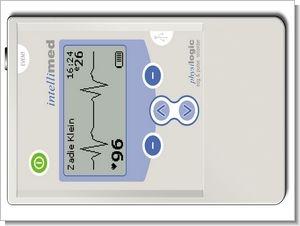
Advanced circuit is quite complicated though most of us can not apply electronic medical medicine but all shared resources software, technical drawings, etc. protel drawings. integrated into the main control used with Texas Instruments MSP430F1232 microcontroller different
ECG Data Logger Project
The objective of this ECG Logger project, sponsored by Intellidesign Pty. Ltd., is to design two ECG holter monitors which meet the standards required for medical devices. One of the devices will have a wireless link, whilst the other will be approximately the size of a credit card.
These devices will be used by cardiologists in the diagnosis of Heart Disease. They are targeted at two different markets – the larger device with a wireless link, has several different modes and is powered by AA alkaline batteries, whilst the smaller device has only one mode and is powered by a lithium polymer rechargeable battery.
Devices like these usually retail for up to $10,000 each and only continuously record for a maximum of 24-48 hours. Due to new battery and memory technologies and ultra low-power ICs, it is now possible to design a device that will last for a minimum of 5 to 7 days. This device will retail for approximately $4-5000. The American Heart Association claims that cardiovascular disease is the cause of an average of 1 death every 33 seconds. In Australia, one person every 10 minutes dies from cardiovascular disease. Hence there is an obvious need for diagnostic devices in the prevention and detection of heart disease.
Second only to cancer, heart disease is the western world’s greatest killer. Improvements in diagnosis and treatment tools are welcomed by the medical community, who are desperately seeking better ways to help their patients. One of the most useful diagnostic tools for heart patients is the electrocardiogram (ECG) which operates by measuring the tiny electrical signals emitted by your heart through chest electrodes. Cardiologists would like to collect large amounts of ECG information from a patient over a long period of time, but crude technologies have limited our ability to perform these long term measurements.
The goal of this project is to develop a device classified as a “Holter Monitor” which outperforms currently available devices, through the use of more powerful components and better manufacturing techniques that were unavailable until recently. It is intended that this very product will go through medical approval and will in a year or two be found saving peoples lives. This device is designed to record two channels of full-spectrum ECG continuously for a week. It stores this enormous amount of information on a Flash memory IC, capable of handling 2GBits of data. Powered by a lithium polymer battery, this extremely low powered device is designed to consume less than 5mA of power in full operation. The device will be the size of a credit card, and we are aiming for a thickness of less than 5mm.
The first stage in producing this device is the creation of a prototype called the “Handheld Logger”. It is functionally identical, but physically much larger than the final “Credit Card Logger”. This thesis has been focussed on bringing the Handheld Logger from a completely fresh start to completion.
MSP430F1232 Firmware
This directory contains a catalogue of the different versions of firmware that were written over the course of the project.
The first firmware that was written was “PinTest”, this was used to test the MSP430 had correctly set up clock and interrupt systems. It simply toggled an output pin when the WDT timed out.
Then was written “ScreenTest” and “ScreenTest2”. They are the code that was used to demonstrate the functionality of the LCD screen. They include all of the graphing and text/number drawing code.
“PWM Test” was the test code used to demonstrate the isolated power supply. This was used to determine the minimum duty ratios required to operate the Flyback converter.
“USB Test” was a simple test program that outputs information to the USB port.
“Firmware Alpha 1” was the first attempt to integrate the software into one single program. It was written simply to demonstrate the successful integration of the different aspects of the code. It was not written for neatness or elegance. “Firmware Alpha 2” contained some improvements.
“Firmware Beta 1” and “Firmware Beta 2” were the first attempts at creating a monolithic system which properly implemented all of the different modules. The key improvement was that this code implemented the I/O scheduler. Unfortunately, this code was written without hardware on which to test. As a result, the code did not work as intended. It was too ambitious to implement this level of code so soon, without strong foundations.
This code was later scrapped, and two other programs, “DemoDay” and “DemoDay2”, were written as derivatives from “Firmware Alpha 1”. These were written in order to demonstrate the full functionality that had been developed, without regard for the correctness of the code.
souce http://innovexpo.itee.uq.edu.au/2003/exhibits/s363025 Portable ECG Data Logger MSP430F1232 LCD alternative link:
Şifre-Pass: 320volt.com
Published: 2009/12/24 Tags: microcontroller projects, msp430 projects
Wireless Oximeter USB PC interface PIC16F876 Measurement
Circuit wirelessly measure the amount of oxygen in the blood of integrated control pic16f876 usb parallel computer link module provided with all the details pc software flow diagrams and shared resource
The medical field has been quick to embrace wireless technology. The advantages in being able to monitor a number of patients from a distance are obvious, and lead to improved efficiency in a busy hospital.
Pulse oximetry is a non-invasive method of measuring a person’s blood oxygen saturation and pulse rate. Its medical applications include the monitoring of patients during anaesthesia, intensive care, or those with conditions such as asthma. The sensor itself is usually in the form of a small clip, worn on the finger, ear, or toe.